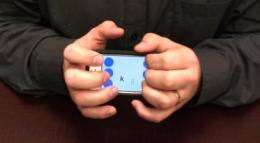Georgia Tech develops braille-like texting app (w/ video)

Imagine if smartphone and tablet users could text a note under the table during a meeting without anyone being the wiser. Mobile gadget users might also be enabled to text while walking, watching TV or socializing without taking their eyes off what they're doing.
Georgia Tech researchers have built a prototype app for touch-screen mobile devices that is vying to be a complete solution for texting without the need to look at a mobile gadget's screen.
"Research has shown that chorded, or gesture-based, texting is a viable solution for eyes-free written communication in the future, making obsolete the need for users to look at their devices while inputting text on them," said Mario Romero, Postdoctoral Fellow in the School of Interactive Computing (IC) and the project's principal investigator.
The free open-source app, called BrailleTouch, incorporates the Braille writing system used by the visually impaired. It has been conceived as a texting tool for any of the millions of smartphone phone users worldwide.
Early studies with visually impaired participants proficient in Braille typing have demonstrated that users can input at least six times the number of words per minute when compared to other research prototypes for eyes-free texting on a touch screen. Users reach up to 32 words per minute with 92 percent accuracy with the prototype app for the iPhone.
"We are currently designing a study to formally evaluate BrailleTouch through both quantitative and qualitative methods," said Caleb Southern, an IC graduate student. "We will measure the typing speed and accuracy of visually impaired users and capture the feedback from study participants in areas such as comfort, ease of use and perceived value."
For sighted users, the research team is exploring how BrailleTouch could be a universal eyes-free mobile texting app that replaces soft QWERTY keyboards and other texting technologies.
"BrailleTouch is an out-of-the-box solution that will work with smartphones and tablets and allow users to start learning the Braille alphabet in a few minutes," said Romero. "It also reduces the need for expensive proprietary Braille keyboard devices, which typically cost thousands of dollars."
The researchers have designed BrailleTouch to address the limitations of soft keyboards, which do not provide tactile feedback, as well as physical keyboards, which often use small and numerous fixed buttons. BrailleTouch is the only iPhone app in existence that uses a six-finger chording process that replicates the traditional Braille keyboard.
The app uses a gesture-based solution by turning the iPhone's touchscreen into a soft-touch keyboard programmed for Braille and requiring only six keys, making it a practical solution for the limited screen real estate on smartphones.
The key feature of the BrailleTouch technology is the use of the six-key configuration so that the keyboard fits on the screen and users keep their fingers in a relatively fixed position while texting. This design allows users to hold their device with the screen facing away from them ¬– cradling the device with their palms or pinkies and thumbs – and to type with a majority of their fingers, identical to typing Braille on a standard keyboard.
The team behind BrailleTouch is led by Romero and IC Professor Gregory Abowd, co-principal investigator. Former IC affiliate Brian Frey conceived the original idea and developed the first prototype and Southern created an improved design. They are conducting usability studies together with James Clawson, a Ph.D. candidate in IC, and Kate Rosier, a master's graduate in Digital Media and bachelor's graduate in Computational Media.
The research group has developed iPhone and iPad versions of BrailleTouch and is currently working on Android versions. The app recently won the MobileHCI 2011 competition for design at the MobileHCI conference in Stockholm, Sweden.
Provided by Georgia Institute of Technology



















